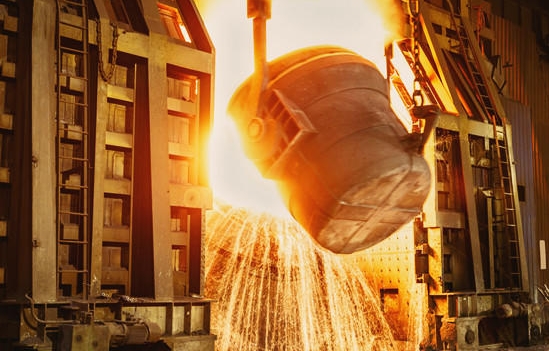- 20
- Nov
Refractory materials for lining of blast furnace
Refractory materials for lining of blast furnace
Refractory materials are used in the throat, body, belly, and hearth of the blast furnace. The refractory brick manufacturers will continue to share for you.

A blast furnace is simply an ironmaking equipment. Iron ore, coke, etc. are introduced from the top of the furnace in proportion, and high temperature blast (1000~1200℃) is entered at the lower tuyere. The oxidation-reduction reaction is carried out in the blast furnace. Iron slag, slag iron flows out from the iron hole at the lower part of the blast furnace to separate iron and slag. The slag enters the slag ditch, flushes the slag or enters the dry slag pit. The molten iron enters the torpedo tank through the swing nozzle or continues to make steel or is sent to the iron casting machine. Finally, the blast furnace gas is discharged through the dust removal equipment. This is the entire process of blast furnace ironmaking.
With the development and progress of the iron and steel industry in various countries, blast furnaces are gradually developing towards large-scale, high-efficiency and longevity, and blast furnace lining refractories have correspondingly higher requirements. Such as good refractoriness, high temperature stability, density, thermal conductivity, wear resistance, erosion resistance and slag resistance.
At present, there are many varieties of refractory materials in blast furnaces, and the use of refractory materials in various parts is different due to the influence of furnace conditions.
At the furnace throat, the refractory masonry is used as a protective lining for reasonable cloth. The temperature is 400~500℃, and it is directly impacted and frictional by the charge, and the effect of air flow is slightly lighter. Here, dense clay bricks, high alumina bricks, clay castables/spray paints, etc. can be used for masonry.
The furnace body part is an important part of the blast furnace, which is used for heating, reducing and slagging of the charge. Here, the erosion of materials and high-temperature airflow is more serious. The temperature in the middle of the furnace body is 400~800℃, and there is no slag erosion. It is mainly affected by the erosion of rising dust, thermal shock, alkali zinc and carbon deposition. Therefore, dense clay bricks and high alumina bricks are used in the upper part of the part, and anti-stripping wear-resistant phosphate clay bricks, high alumina bricks, and sillimanite bricks are used for masonry; the lower part of the furnace body uses dense and wear resistant clay bricks, high alumina bricks, and corundum bricks. , Carborundum bricks for masonry.
The abdomen of the furnace acts as a buffer for the updraft, where part of the charge is reduced and slagging, and the furnace lining is severely corroded by iron slag. The temperature here is as high as 1400~1600℃ in the upper part and 1600~1650℃ in the lower part. Due to the comprehensive effects of high temperature radiation, alkali erosion, hot dusty rising furnace gas, etc., the refractory materials of the furnace lining here are seriously damaged. Therefore, refractory materials with strong resistance to slag erosion and erosion and abrasion should be selected here. The furnace belly can use low-porosity clay bricks, high alumina bricks, graphite bricks, silicon carbide bricks, corundum bricks, etc. for masonry.
The hearth is the place where the molten iron and the molten slag are loaded. The highest temperature in the tuyere area is 1700~2000℃, and the temperature of the furnace bottom is 1450~1500℃. In addition to being affected by high temperature, the hearth lining is also eroded by slag and iron. The hearth tuyere can use corundum mullite bricks, brown corundum bricks, and sillimanite bricks for masonry. Corundum mullite bricks and brown corundum bricks are used for the hot surface of the slag-iron contact, and dense carbon bricks and graphite semi-graphite bricks are used for the cold surface. Carbon bricks, microporous carbon bricks, molded carbon bricks, sidewall brown corundum low cement prefabricated blocks, hearth hot-pressed small carbon bricks, furnace bottom using graphite semi-graphite carbon bricks, microporous carbon bricks, etc. for masonry.
In addition, clay bricks, silicon carbide bricks, graphite bricks, fused corundum castables, silicon carbide castables, iron ditch thermal spray repair materials can be used for the blast furnace iron trough. The ditch cover uses low cement and high aluminum castables and the skimmer part Using low cement corundum castable, the refractory material of the swing nozzle is similar to that of the iron ditch, and the slag ditch can be made of slightly lower material.
